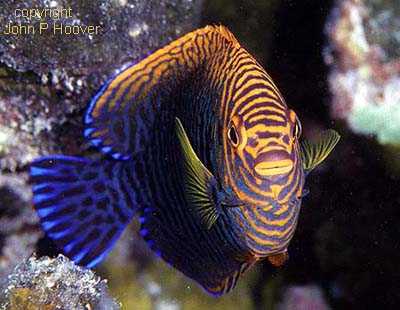
male
- Kahe Point, O`ahu. 25 ft. |
|
POTTER'S ANGELFISH
Centropyge potteri (Jordan & Metz, 1912)
The only truly common angelfish species
in Hawai`i, Potter's Angel is rusty orange overall with many irregular,
vertical gray-blue lines. The orange darkens to bluish black on
much of the lower side and this dark area is larger in males than
in females, making them easy to distinguish in the field (i.e. females
show more orange). The edges of the rear fins are striped horizontally
with bright blue and black. Males have more blue on the fins than
females and their bodies are slightly more elongate. Some individuals
are much darker than others and a rare all blue-and-black specimen
has been photographed by Hiroyuki Tanaka.
Potter's Angels live in pairs or
in small groups of a male and several females, usually in clear
water at depths of 10-150 ft. under ledges or on reef slopes with
plenty of shelter holes. One researcher ranked them among the ten
most frequently seen fishes in such areas. They feed on detritus
and algae and although they inhabit a specific territory they do
not defend it from other algae-eating fishes. (The male does defend
his harem and breeding territory from other males, however.) These
fish can be hard to see without scuba, but adventuresome snorkelers
on O`ahu might find them off the cliffs at Kawaihoa (Portlock) Point,
where for some reason they are frequently in the open. Big Island
snorkelers can see them at Hönaunau or Kealakekua Bay in only
a few feet of water. Divers, of course, will see them almost anywhere,
peering from the coral and darting from one hiding place to the
next.
In
captivity they do well if given peaceful tankmates and plenty of
time to adjust. Like many angelfishes they are slow to begin feeding.
They rank third in importance among Hawaiian fishes exported for
the aquarium trade. The name honors Frederick A. Potter (1874-1961),
director of the Waikïkï Aquarium from its founding in
1903 until 1940. To 5 in. Endemic.
|
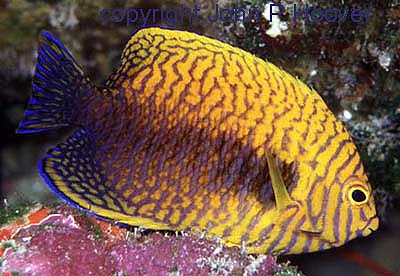
female - Makua,
O`ahu. 100 ft. |
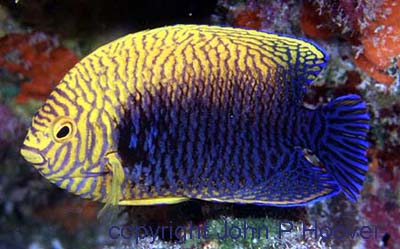
male - Makua, O`ahu. 100 ft. |
|
POTTER'S
ANGELFISH REPRODUCTION
Potter's Angelfish spawn around dusk
generally over the highest outcropping of rock or coral in their
territory. Reproductive activity is highest from December through
May. Dr. Philip Lobel once recorded an entire spawning session on
film. About one hour before sunset a male approached a female, swimming
with a distinct vertical undulating motion. Stopping above her he
erected dorsal and anal fins, fluttered his pectoral fins, turned
partially on his side, and drifted slowly upward as he fluttered.
When the female did not follow, he darted back down and swam around
her with the undulating motion again, swooping up and down. Courtship
continued until the female responded. By this time both fish had
considerably intensified their red coloration and were producing
audible clicks and grunts. The male then led her to a prominent
outcropping and rose above it about 3 ft, the female following.
She darted back prematurely the first few times, but the male, continuing
his display, finally enticed her to remain in midwater, where he
approaching her from underneath. He nuzzled her vent with his snout
until she released a single burst of eggs. Simultaneously, he released
his sperm, then both darted to cover with the female chasing the
male and nipping at his tail fin. Soon after, the two hid themselves
for the night.
|
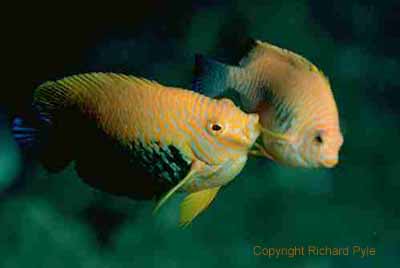
spawning - photo
by Richard Pyle |
| Unless
spawning, Potter's Angelfish rarely swims in the open. The one below,
however, has ventured quite far from cover to browse on algae growing
on the shell of a Green Turtle. Turtles regularly come to cleaning
stations such as this one (located at the dive site called Five Graves
at Makena, Maui) to have algae removed from their shells. Surgeonfishes
of several species commonly perform this service but it is unusual
in Hawai`i to see an angelfish doing it. |
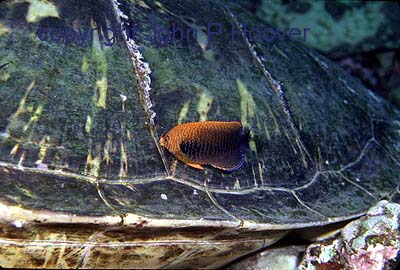
Makena, Maui. 40 ft. |
|




